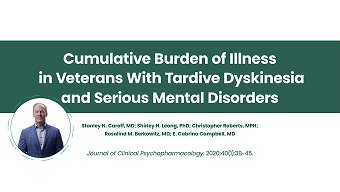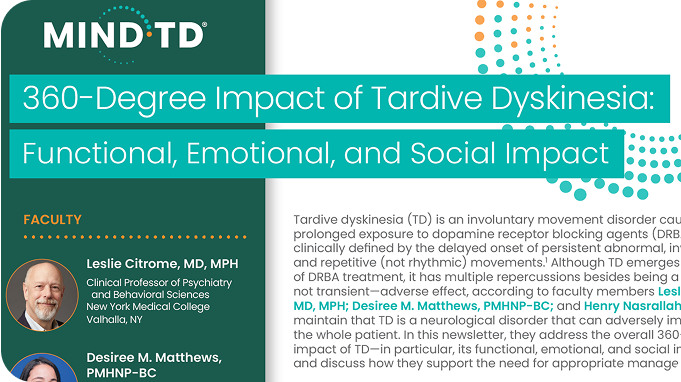

~10 mins
•Jan 2025
Cumulative Burden of Illness in Veterans With Tardive Dyskinesia and Serious Mental Disorders
TD involves specific types of uncontrollable movements in the face, torso, and limbs.1 Unlike other movement disorders, TD involves repetitive, stereotypical, athetoid (writhing) movements.2
Facial (oro-buccal-lingual) movements
Repetitive chewing movement, sometimes with smacking or puckering lips, sticking out tongue, puffing out cheeks, frowning or grimacing, and grunting3-5
Truncal movements
Axial pulling or twisting, shoulder shrugging, rocking and swaying, and rotating or thrusting hips3
Extremity movements
“Piano-playing” fingers, splayed or hyperextended toes, and foot tapping3
Signs of TD develop during antipsychotic exposure or within 4 weeks of withdrawal (or 8 weeks of withdrawal from a long-acting injectable). There must be a history of use of the agent for ≥3 months (or 1 month in individuals ≥60 years). Abnormal movements must persist for at least 4 weeks.1,6
What kinds of truncal movements may be observed in patients with TD?
Even "mild TD movement severity" has the potential to impact patients’ physical functioning, including mobility, pain/discomfort, self-care, and ability to perform usual activities. It can also affect their psychological wellbeing—decreasing confidence, self-esteem, and self-worth.5,7,8 Many patients may start skipping doses of their antipsychotic medication, or stop going to see a healthcare provider. Their uncontrolled movements may also impair their ability to work or may cause them to miss work.8

Beyond Movement: Appreciating the Social Impact of Tardive Dyskinesia
Listen to Dr Greg Mattingly, a psychiatry expert in St. Louis, Missouri, and Tammy LeBlanc-Russo, a psychiatric nurse practitioner in Upstate New York, discuss the social impact of TD

~3 mins
•Feb 2022


~10 mins
•Jan 2025


~3 mins
•Feb 2022
“Are You Really Okay?” How Tardive Dyskinesia Affects Day-to-Day


~5 mins
•Dec 2024
Now learn about the tests used to screen for and diagnose TD.
References
American Psychiatric Association. Diagnostic and Statistical Manual of Mental Disorders. 5th ed., text rev. American Psychiatric Association; 2022.
Fahn S, et al, eds. Principles and Practice of Movement Disorders. 2nd ed. Saunders; 2011:415-446.
Tarsy D. Curr Treat Options Neurol. 2000;2(3):205-214.
Lumetti S, et al. Case Rep Dent. 2016;2016:7167452.
McEvoy J, et al. Qual Life Res. 2019;28(12):3303-3312.
American Psychiatric Association. Diagnostic and Statistical Manual of Mental Disorders. 5th ed., text rev. American Psychiatric Association; 2022.
Tanner CM, et al. J Patient Rep Outcomes. 2023;7(1):21.
Jain R, et al. J Clin Psychiatry. 2023;84(3):22m14694.